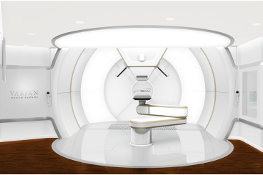Compare costs
Average cost of treatment in key countries
Include indicative costs for treatment, travel, insurance and accommodation
Get a quote
1. Complete the enquiry form
2. Select countries of interest
3. Providers respond directly
Proton beam therapy is a type of radiotherapy. It differs from the usual type of radiotherapy that many cancer patients receive as part of their treatment. To explain proton beam therapy, it’s important to understand a bit about ordinary radiotherapy.
Most radiotherapy treatments involve using high energy X-rays, which are directed towards a tumour with the intention of destroying the cancerous cells. X-rays destroy cells by messing with their DNA, leaving them completely unable to divide or function properly.
The problem with radiotherapy based on high energy X-rays is that it can’t tell the difference between a cancer cell and a healthy body cell. This is particularly devastating in children with cancer.
Radiotherapy can treat childhood cancer very effectively but it can also lead to tissue and organ damage during treatment, which can cause health problems in later life. Mental development, hearing and sight can be affected. If tissue within an organ such as the heart results, heart failure can develop, and general cell damage can lead to radiation-induced cancers.
A great deal of effort in the last three decades has been spent making radiotherapy as accurate as possible. Image guided radiotherapy and intensity modulated radiotherapy techniques control the dose of X-rays and the path they take when entering and leaving the body.
Even so, the best and most accurate radiotherapy carries a significant risk of side effects because it damages the normal tissue near to the tumour.
The first difference is that it uses a stream of positively charged protons rather than high energy X-rays. Protons also carry a lot of energy and can disrupt the DNA of cells in an equally destructive way. Unlike X-rays, proton beams lose their energy much more quickly as they enter tissue.
This means the bulk of their energy is released into the tumour, leaving very little to affect the healthy cells either in front or behind the tumour, or at either side. Proton beams can be directed into the three-dimensional space occupied by a tumour using complex equipment and computer-driven technology.
Theoretically, proton beam therapy should be just as effective as standard image-guided and intensity-modulated radiotherapy but it should have far less side effects. In a way, that does make it a better option, but this may not be true in all patients and for all cancers.
Proton beam therapy has some definite applications and for some cancers in some patients, it could be the best form of radiation treatment.
The development of proton beam therapy is particularly exciting for the treatment of all localised tumours that are surrounded by delicate and easily damaged structures – such as tumours in the brain, eye, prostate, spinal cord, particularly when these are diagnosed in children.
Cost is seen as one of the major disadvantages of proton beam therapy. The actual individual treatments cost three times more than standard radiotherapy. But beyond that, the set up costs are huge. A cyclotron or synchrotron, the machine used to create the proton beam, typically costs around £100 million. The two new proton beam therapy centres planned for Manchester and London in the United Kingdom are costing £250 million.
The idea of using positively charged protons in medicine dates back to 1946. Robert Wilson, a scientist working on the design of the Cyclotron Lab at Harvard University proposed it in a published paper but the first treatments were not performed until the 1950s.
Patients were treated at Berkeley in the USA in 1954 and at Uppsala in Sweden in 1957. The Harvard Cyclotron formed a partnership with the Massachusetts General Hospital and continued research on using protons to treat cancer through the next five decades. Research also started in Japan at the National Institute of Radiological Sciences in 1979 and later at the University of Tsukuba.
The first proton beam therapy centre to become fully operational in a hospital setting was the one at Loma Linda in California in the USA, which opened in 1990. Centres in Japan opened shortly afterwards and the USA and Japan still lead the world in terms of treatment facilities and number of patients treated.
See our complete list of proton beam therapy centres currently offering treatment worldwide.


The King Hussein Cancer Centre treats all cancers and performs approximately 300 bone marrow transplants a year. The King Hussein Cancer Centre is the one of the only specialised cancer centres in the Middle East treating both adults and children. They also offer various diagnostic imaging services such as MRI and CT scans and have a highly advanced Chemotherapy Unit.

